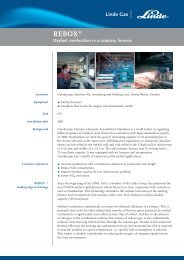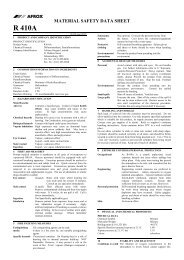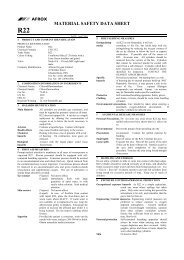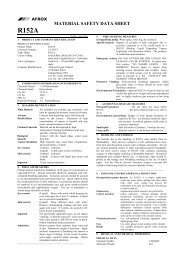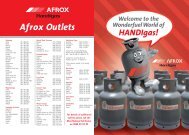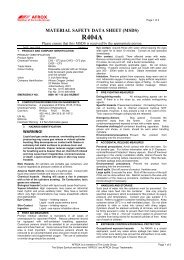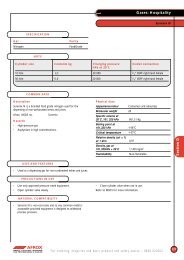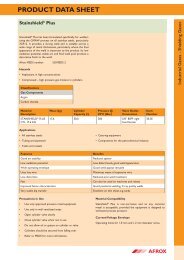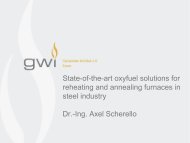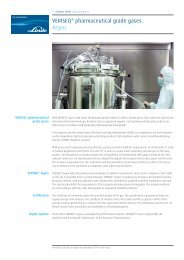Oxyfuel article, Iron & Steel Technology, May 2005 - Linde North ...
Oxyfuel article, Iron & Steel Technology, May 2005 - Linde North ...
Oxyfuel article, Iron & Steel Technology, May 2005 - Linde North ...
You also want an ePaper? Increase the reach of your titles
YUMPU automatically turns print PDFs into web optimized ePapers that Google loves.
Table 1Calculated Equivalent NOx Emission Levels for Oxy-fuel Comparedto Air-fuelCalculated equivalentMeasurement Air-fuel oxy-fuelConcentration (ppm) 171 2,120Emissions of NO 2 over time (lb./hr.) 7.94 7.94Emissions of NO 2 from energy used (lb./mmBtu) 0.2324 0.3462Dry exhaust (scfh) 390,937 31,459Wet exhaust (scfh) 466,142 81,962NO 2 for the steel produced (lb./ton) 0.325 0.325Energy to steel heated (mmBtu/ton) 1.154 0.773Power installed (mmBtu/hr.) 34 23Leak air (scfh at 3% excess oxygen) 4,526.8Figure 7The compact 6.82 mmBtu/hour oxyfuelburner was installed for a boostingapplication next to the 1.7 mmBtuair-fuel burner in a pusher furnace.At 3% excess oxygenon fuel type. However, customers require suppliersto fulfill the level of 70 mg/MJ (0.1627pound/mmBtu), which has become theindustry standard. Figure 6 shows that evenlower emission levels could be achieved withnew flameless oxy-fuel technology developedby <strong>Linde</strong>.Oxy-fuel combustion reduces the amount ofNOx produced, but the concentrationappears high. This is due to the absence ofnitrogen in the combustion process and thusmuch smaller flue gas volume. In Table 1, atidentical production output with a constantemission of 7.94 pounds NO 2 /hour, the calculatedequivalent emissionconcentration (ppm)values for oxy-fuel arehigher. For this reason,the emission of NOx is betterexpressed as producedNOx (pounds) in relationto energy consumed(mmBtu) or the volume ofsteel produced (tons), asdescribed in Table 1.These oxy-fuel values arenot actual, since they aretypically much below0.3462 pound/mmBtu.The correct measurementequipment must alsobe used, as traditionalanalysis tools cannot measurethe high concentrationof CO 2 .Oxy-fuel — PowerfulYet Simple to InstallThe fact that oxy-fuel combustiondoes not have totake the nonproductive nitrogenballast into account implies bothpractical and cost-effective solutionsin regard to the application of thetechnology as well as maintenance.There is no longer any need forlarge burners or combustion airducts, which often require electricblowers. Oxy-fuel burners are smallin size and easy to retrofit in anexisting furnace, either for boostingor as a 100-percent oxy-fuel application.In a boosting application, oxyfuelburners either replace some airfuelburners or are additionallymounted, as in Figure 7, next toexisting air-fuel burners. The objectiveis to give an extra capacity boostor reduce temperature differencesin the material heated. A modern,water-cooled, flameless oxy-fuelburner with a 8.5 mmBtu/hourpower rating, integrated UV and pilot burnerweighs 20–45 pounds. The space-efficientburners are easily installed and accessible forinspection and maintenance.A great benefit is the fact that bulky exhaustgas ducts and recuperators, and the associatedelectric ventilation fans, are no longerrequired. Scrubbers and other flue gas cleaningsystems can also be eliminated, thus reducingboth installation costs and maintenance.In regard to the design of new reheat andannealing furnaces, oxy-fuel technology facilitatesmore compact furnace designs for thesame output capacity as an air-fuel furnace.The application of oxy-fuel in an existing furnace,previously equipped with air-fuel,increases the production capacity, avoidingthe need to extend the furnace or purchasean additional unit. This is of considerableinterest, as material logistics, production linesetup and the floor space available within anexisting rolling mill or forge shop are normallyboth expensive and time-consuming toincrease or alter.The knowledge of customer processes, therequirements imposed by authorities andrecent technical breakthroughs have driven<strong>Linde</strong>’s development of oxy-fuel combustion,not only in terms of burner technology, butalso in terms of correct measurement, efficientcontrol systems and new regulationmodels, as well as a thorough understandingof furnaces.Oxy-fuel — Challenging but HighlyRewardingThe following are examples from more than80 oxy-fuel installations implemented by<strong>Linde</strong> Gas since 1990.208 ✦ <strong>Iron</strong> & <strong>Steel</strong> <strong>Technology</strong>
Figure 8The Timken Co., U.S. — In 1990, Timken wasthe first to commission a 100-percent oxy-fuelinstallation in their soaking pits, used to heatbearing steel ingots prior to rolling. They havebenefited from a 63 percent reduction in specificfuel consumption, 74 percent less flue gasemissions, and heating time reduction from 5hours to 2.5–3 hours. Scale has also beenreported as easy to remove.Böhler-Uddeholm, Sweden — A 52 percentreduction in specific fuel consumption wasachieved since the installation of oxy-fuel infive car-bottom furnaces at Böhler-Uddeholm.The first installation took place in 1993. Thesefurnaces heat 8- to 77-ton ingots prior to forging.The heating time could be reduced by25–50 percent with improved surface qualityand reduced scale formation.Ovako <strong>Steel</strong>, Sweden — Since 1994, the SKFsubsidiary Ovako <strong>Steel</strong> has used oxy-fuel in atotal of 42 pit and rotary hearth furnaces. Thishas increased throughput capacity by 35 percent,creating flexibility in production rates,shift forms and maintenance planning. Fuelconsumption and CO 2 emissions are down by35 percent. A new rotary hearth furnace wascommissioned in 1998, incorporating oxy-fuelfor maximum performance. 7 A photograph ofthe Ovako operations is shown in Figure 8.<strong>North</strong> American Forgemasters, U.S. — Since1999, NAF has been using oxy-fuel in six boxfurnaces for heating ingots prior to forging.Energy consumption for oxy-fuel was 56 percentless than in the air-fuel furnace with thesame charge and heat cycle. NOx emissionsfor the oxy-fuel furnace were about 50 percentof air-fuel NOx emissions. A 10 percentincrease in the heating rate was measuredwith the oxy-fuel furnace, which is likely dueto faster ramp to temperature setpoint.Outokumpu Stainless, Sweden — In 2001, acatenary furnace for annealing stainless steelstrip at Avesta works was refurbished.Production throughput was raised from 82 to165 tons/hour. Staged combustion oxy-fuelburners with a total power of 133mmBtu/hour were installed, making it one ofthe largest oxy-fuel installations of its kind.Fuel consumption was reduced by 40 percentcompared with the previous operation usingair-fuel burners and recuperators.In 2003, <strong>Linde</strong> Gas refurbished the existingwalking beam furnace at the Degerfors works.The complete turnkey project included therebuilding and refurbishment of the existingfurnace, the application of flameless oxy-fueltechnology and the installation of essentialcontrol systems during a 25-day stoppage.At Ovako <strong>Steel</strong>, ingots are heated to 2,200°F in oxy-fuelconverted pit furnaces prior to downstream hot rolling.Performance was guaranteed, with a productionincrease of 30 percent, reduced fuel consumption,lowered NOx emissions andimproved temperature uniformity.Recent DevelopmentsFlameless Oxy-fuel — Ultralow-NOx andLarge Furnaces — The legislation relating toNOx emissions is strict, and permissible emissionlevels are constantly being reduced.Against this background, development workwas begun in collaboration with customers tofind even more effective oxy-fuel solutions.The work also aimed at finding more ruggedinstallations for implementation, as well asoxy-fuel solutions viable in larger furnacessuch as catenary, pusher and walking beamfurnaces.A key parameter in achieving low NOx isthe reduction of flame temperature. Below atemperature of 2,600°F, NOx formation is limited,but a dramatic increase in NOx occursabove this temperature. One way of reducingthe flame temperature is to use the principleof flameless combustion. This principle hasbeen known for many years, but it has onlyrecently been industrially exploited.The term flameless combustion expresses thevisual aspect of the combustion type, i.e., theflame is no longer seen or easily detected bythe human eye (Figure 9b). A more accuratedefinition would be that combustion is dilutedby different means and thus spread out in alarge volume, which some scientists refer to asvolume combustion, resulting in a lower flametemperature.The solution of diluting the combustionand flame uses either dilution or the injectionof fuel and oxygen at high velocities separatedfrom each other. In a conventional stableflame burner, the flame is almost a field discontinuity,depends on fluid dynamics with<strong>May</strong> <strong>2005</strong> ✦ 209
Figure 9(a) A conventional oxy-fuel flame, and (b) the same burner in flameless mode (i.e.,invisible volume combustion).Figure 10(a)(b)computational difficulties, and involves complexreaction paths with abundant formation ofradicals and intermediate products. The gradual,volume-distributed reaction rate typical offlameless and staging combustion is moreaccurately controlled. The mixture of fuel andoxidant reacts anyway, irrespective of proportion,without support of a flame front and withkinetics dictated mainly by temperature. 8In addition to reducing the temperature ofthe flame, flameless oxy-fuel burners effectivelydisperse the combustion gases throughoutthe furnace, ensuring more effective and uniformheating of the material with a limitednumber of installed burners. Figure 6 showedthat flameless oxy-fuel technology is insensitiveto air ingress when it comes to NOx emission.The test was performed in a pilot-scalefurnace where ingress air was simulated byleaking air into it in order to raise the freeoxygen content in the combustion gases. Theoxygen content was measured in the flue. Theflameless oxy-fuel solution proved to bealmost insensitive to the air ingress, and conventionaloxy-fuel had similar emissionsof NOx as state-of-the-artregenerative air-fuel technology.This is of great benefit, particularlyin old and continuous furnaces.Since 2003, two full-scale applicationshave been installed usingflameless oxy-fuel burner technology.These include heating in reheatfurnaces and annealing lines, walkingbeam and pit furnaces, and acatenary furnace. This has led to thepossibility of meeting the demandfor further increased productionthroughput in existing furnaces,while at the same time fulfillinglocal authorities’ stipulated lower levels ofNOx emissions.Direct Flame Impingement — ExtremeHeating in a Limited Space — Direct flameimpingement (DFI), where an oxy-fuel flamedirectly heats moving metal, has proved to bethe most effective way of increasing heat transfer.The principle is taken from the reheatingof metal surfaces by torching prior to welding.DFI is of particular interest when extremeheating is required but there are severe spacerestrictions. A typical example is shown inFigure 10. The customer, having a catenaryfurnace for strip annealing, was alreadyequipped with oxy-fuel and wanted to increaseproduction capacity by 50 percent withoutextending the length of the furnace. A compactunit was designed for retrofitting on theentry side of the furnace, which containedfour cassettes each with 30 oxy-fuel burners,giving a total of 120 burners and a total poweroutput of 13.7 mmBtu/hour.Direct application of oxy-fuelflames onto the continuously movingmaterial has proved to be a powerfuland space-efficient solution forthe existing furnace to boost capacityand to even out temperature differencesin the material.The photograph shows the compact DFI unit of 13.7 mmBtu/hour, which booststhroughput capacity by about 50 percent in a catenary furnace at OutokumpuStainless.SummaryEliminating the nitrogen ballast inthe combustion and heat transferprocess by replacing the air withindustrial-grade oxygen cuts fossilfuel consumption by up to 50 percentand reduces CO 2 levels correspondingly.Further reduction offuel and CO 2 is possible through theuse of low-caloric energy forms, asacceptable flame temperatures canbe achieved with oxygen.NOx levels can also be kept low, asthere is no nitrogen in the oxy-fuel210 ✦ <strong>Iron</strong> & <strong>Steel</strong> <strong>Technology</strong>
combustion process. Furnace control is good,and the flame temperature of modern oxyfuelburner technology is lower.Furnace throughput can be boosted by upto 50 percent, providing extra productioncapacity, which can be used to concentrateproduction and better accommodate peak volumesand maintenance activities. Oxy-fuelinstallations are powerful and space-efficientand are thus easy to retrofit in any existing furnace,requiring less maintenance compared toair-fuel systems with ventilator fans, bulky fluegas systems and recuperators.Oxy-fuel technology is no longer simply awell-known means of improving steelmaking.Since 1990, <strong>Linde</strong> has proved in more than 80installations the viability of oxy-fuel technologyin creating effective total cost solutions inapplications for reheat furnaces and annealinglines.References1 . Eichler, R., “Recent Developments in Oxy-fuel<strong>Technology</strong> for Heating Furnaces,” Proc. IFRF’s 25thToTeM, Oct. 22–23, 2003, Stockholm, Sweden, pp.2–7.2 . Ebeling, C.; Axelsson, C.-L.; and Coe, D., “<strong>Oxyfuel</strong>Applications for <strong>Steel</strong> Reheating Furnaces,” AISE<strong>Iron</strong> & <strong>Steel</strong> Exposition & Annual Convention, Sept.27–30, 1999, Cleveland, Ohio.3. von Schéele, J., “Short-term opportunities fordecreasing CO 2 emissions from the steel industry,”Proc. SCANMET II, June 6–9, 2004, Luleå, Sweden,Vol. I, pp. 283–292.4. Holm, B., et al., “Oxidation and pickling of stainlesssteel when annealing with oxy-fuel,” Proc. STÅL2004, <strong>May</strong> 5–6, 2004, Borlänge, Sweden, pp.65–66.5 . Ljungars, S.; Gartz, M.; and von Schéele, J.,“Boosting heating capacity using new technology,”Nordic <strong>Steel</strong> and Mining Review, Sweden, 2004, pp.49–50.6 . Sandberg, H., et al., “CO 2 emissions of theSwedish steel industry,” Scand. J. Met., 30 (2001), pp.420–425.7 . Arvidsson, L.; Gartz, M.; and von Schéele, J.,“Oxy-fuel — demanding but highly rewarding,” Nordic<strong>Steel</strong> and Mining Review, Sweden, 2003, pp. 20–21.8. IFRF Combustion Handbook,http://www.handbook.ifrf.net.9. Krishnamurthy, N.; Blasiak, W.; and Lugnet, A.,“Development of high-temperature air and oxy-fuelcombustion technologies for minimized CO 2 and NOxemission in industrial heating,” Joint InternationalConference on Sustainable Energy and Environment,Dec. 1–3, 2004, HuaHin, Thailand, Vol. II, pp.552–557.This paper was presented at AISTech 2004 — The <strong>Iron</strong> & <strong>Steel</strong> <strong>Technology</strong>Conference and Exposition, Nashville, Tenn.<strong>Linde</strong> AG<strong>Linde</strong> Gas Division, Seitnerstrasse 70, DE-82049 Höllriegelskreuth, GermanyPhone +49.89.74 46-0, Fax +49.89.74 46-12 30, www.linde-gas.com/REBOX




